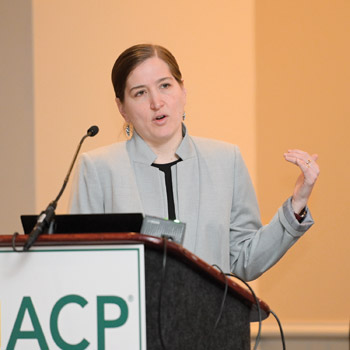To test or not to test for inherited thrombophilias
First consider whether a deep venous thrombosis was provoked or unprovoked, as well as at the type of provoking factors.
Just because you can test for inherited thrombophilias doesn't always mean you should, according to Martha P. Mims, MD, PhD. At an Internal Medicine Meeting 2019 session, “Who Really Needs a Work-up for Hereditary Thrombophilia?”, she outlined how to decide on therapy for venous thromboembolism (VTE), as well as some instances where testing might change management and an overview of direct-acting oral anticoagulants (DOACs).

“One question that I get a lot is a primary care doctor will send a patient to me and ask ‘How long do I have to anticoagulate this patient?’ There's not really a hard-and-fast rule, so it requires a little bit of thinking,” said Dr. Mims, who is a professor and chief of hematology and oncology in the department of medicine at Baylor College of Medicine in Houston. “There's a lot of anxiety related to having a clot and knowing what to do.”
Provoked or unprovoked?
To help with the decision whether to test, Dr. Mims advised looking at whether a deep venous thrombosis (DVT) was provoked or unprovoked, as well as at the type of provoking factors. Transient major provoking factors include major surgery, fractures or major trauma, joint replacement, immobilization for more than three days, and pregnancy or oral contraceptives, while transient minor provoking factors include minor surgery, immobilization for less than three days, and minor leg injuries.
Persistent major provoking factors include malignancy, high-risk thrombophilia like antithrombin deficiency, and a history of DVT. “Once you've had a DVT, the risk of having another one is there, and you have to talk to people and think about that,” said Dr. Mims. Age, on the other hand, is considered a minor persistent provoking factor.
Unprovoked DVTs without risk factors are particularly problematic, Dr. Mims said. “When somebody has a DVT out of the blue—they haven't been on a long plane trip, they're not obese, they haven't had an injury, or you can't really put a risk factor there—that actually puts people at a higher risk of having a recurrence.”
For provoked DVTs, Dr. Mims said, she considers the risk factors and whether they are things she can change, like oral contraceptive use, or if they're persistent, like an underlying malignancy. “And interestingly, I'm not sure how many people know about this, being a man puts you at higher risk of recurrence,” she said. “I don't know why that is, we're not sure why that is, but it's certainly true.”
At the initial diagnosis of VTE, everyone should get anticoagulation unless there is a strong contraindication, she said. “The exceptions to this might be every once in a while you'll get a CT chest for somebody, and you'll see there's a distal thromboembolism there that's tiny, in a subsegmental vein. There is a lot of discussion going on now whether those asymptomatic subsegmental [pulmonary embolisms] need to be anticoagulated,” Dr. Mims said. “But if you've got somebody with a proximal blood clot in an arm or a leg, that needs to be treated.”
In the acute period of a clot, there's probably no point in testing for thrombophilias, Dr. Mims said. “It's not going to affect what you do for the next three months, you're going to get inaccurate results, your patient's going to have to pay for it, and it's not going to be helpful to them,” she said.
Length of therapy
Dr. Mims said she is often asked about when to use thrombophilia testing to help determine length of therapy. For a provoked DVT with major or transient risk factors, anticoagulation can probably be stopped at three months. However, with unprovoked DVT, it's probably best to lean toward long-term anticoagulation, “but that can be tricky,” Dr. Mims said. “Patients don't want to take it, they want some proof, they want you to show them hard evidence. And it's really those unprovoked DVTs where you might want to give some thought about thrombophilia testing if it's going to push you one way or the other.”
These cases require evaluation of clotting risk as well as bleeding risk, Dr. Mims said. “Sometimes we don't think about that. We just really focus on ‘They've had a blood clot, we're worried they're going to have another blood clot,’ but you have to think about bleeding risk as well,” particularly in older patients.
Patient preference should also be considered, she said. If a patient says she has no problem taking her apixaban, for example, “I'm more likely just to leave them on there or maybe put them on a lower dose of apixaban than to take them off.”
Dr. Mims provided a rundown of the recurrence risk for each type of inherited thrombophilia and how that affects her decision to do thrombophilia testing in patients with unprovoked DVT. People with factor V Leiden mutation and prothrombin gene mutation have about the same recurrence risk as the general population, “so I don't really think too much about it,” she said. “I might find it, but it doesn't really tell me too much about recurrence risk.”
For protein S and protein C deficiency, recurrence risk is not that high unless there's family history of clots, she said. “[If] somebody comes to you with a family history, you might consider protein C or S testing.” Antithrombin is probably associated with the highest recurrence risk, especially if family history is present, she noted. “If I'm going to pick things to test, antithrombin would be way up there on my list.”
In general, testing for inherited thrombophilias is probably only useful if a DVT is unprovoked, if the patient has a strong family history, and if withdrawal of anticoagulation is being considered. “The data really favor only testing for antithrombin, protein S, and protein C, because that's really where the high risks are in terms of unprovoked DVTs,” she said.
Family members, asymptomatic carriers
Family members of patients with VTE are often concerned about how genetic factors may influence their own risk. “I see this all the time,” Dr. Mims said, “so what do I tell them?”
For starters, she said, oral contraceptives should raise a red flag in these patients. Women with protein C or protein S deficiency should not take oral contraceptives at all due to high VTE risk. “The problem is … that even patients who test negative, in families where there've been blood clots, are at higher risk, so if somebody gives me a pretty good history of having had blood clots in their family, I am probably not going to give them [oral contraceptives],” she said.
Pregnant women with a family history of VTE have a general VTE risk of 0.5% even if they test negative for any mutation, Dr. Mims said. However, for patients who have a family history but not a known thrombophilia, it's probably not worth testing “because you're kind of shooting around in the dark,” she noted.
With the increase in genetic testing in recent years, many people who are asymptomatic carriers are more aware of their mutation status, Dr. Mims said. “A lot of people will come to you and say ‘I have factor V Leiden,’ like it's a disease,” she said. “It's not really a disease … it's fairly common.”
Hospitalization is even more common risk factor for thromboembolism. In acutely ill medical patients, low-molecular-weight heparin (LMWH) or unfractionated heparin is recommended for everyone to prevent clots, regardless of mutation status, Dr. Mims said. LMWH is recommended over mechanical prophylaxis and over DOACs, she noted, and the most recent guidelines from the American Society of Hematology (ASH) recommend against using both LMWH and mechanical prophylaxis. “So pick one, and stick with it,” Dr. Mims said. “The belt-and-suspenders approach is not needed here.”
For long-distance travel, the ASH recommends that VTE prophylaxis should be considered only in people with more than one risk factor, such as recent surgery, VTE history, oral contraceptive use, or pregnancy. Having recently had a baby counts as a risk factor too, Dr. Mims said: “We're at higher risk for having a blood clot in that six to 12 weeks after we have a baby than we are in the whole pregnancy.”
In fact, the question of pregnancy and anticoagulation is “always anxiety-provoking,” Dr. Mims said. Current guidelines from ASH recommend against antithrombotic prophylaxis in pregnant women who are protein C/protein S heterozygotes and factor V Leiden/prothrombin 20210 heterozygotes, as well as in those with antithrombin deficiency and those who are homozygous for prothrombin 20210. Prophylaxis is recommended, however, in pregnant women with antithrombin deficiency and a family history of DVT and those who are factor V Leiden homozygotes or who have multiple thrombophilias.
“They have more than one risk factor, and they should get [prophylaxis] during pregnancy,” Dr. Mims said.
In the postpartum period, women who are factor V Leiden/prothrombin 20210 heterozygotes with or without a family history don't need antithrombotic prophylaxis, Dr. Mims said. This is also true for women who are protein C/protein S heterozygotes with no family history, but for those who do have a family history, prophylaxis should be considered. Patients with antithrombin deficiency and a family history of VTE should receive prophylaxis, while those without a family history should not. Prophylaxis is recommended in patients who are homozygotes for factor V Leiden or prothrombin 20210, or those who have multiple thrombophilias, Dr. Mims said: “Those patients should have prophylaxis during that six- to 12-week period after delivery.”
Pros, cons of DOACs
Data on the use of dabigatran, rivaroxaban, apixaban, and edoxaban in patients with thrombophilias are sparse, Dr. Mims noted. “They're probably safe for patients with factor V Leiden and prothrombin gene mutations because those are very common, and surely there are patients [in the large studies of DOACs] who didn't know they had that,” she said.
For protein S deficiency, warfarin may be a bit better than DOACs, and the reverse may be true for protein C deficiency, but these conclusions are based on data from case reports and are mainly theoretical, Dr. Mims said. No data are currently available for the use of DOACs in antithrombin deficiency or combined deficiencies. “I will say that … for antiphospholipid antibody syndrome, most people are recommending against the use of the DOACs, particularly if you have multiple components of the antiphospholipid syndrome in place,” she said.
When talking to patients about anticoagulation, review the pros and cons of DOACs, Dr. Mims recommended. Pros include that they are oral, don't need to be bridged with heparin, have few interactions with other drugs, and have a lower bleeding risk. Also, “You don't have those awful dietary restrictions, telling people not to eat salad,” she said.
Apixaban and rivaroxaban have relatively low rates of renal clearance and are therefore reasonable choices in patients with borderline kidney function, Dr. Mims said. Patients with percutaneous endoscopic gastrostomy (PEG) tubes can benefit from these drugs, also, because they can be crushed and dissolved. Monitoring is not needed with DOACs as it is with warfarin, and DOACs may also be attractive because lower doses can be used for maintenance in high-risk patients after the first three to six months of therapy, she said.
Cons of the DOACs, meanwhile, include their short half-life, meaning that missed doses are critical. “If you've got a patient who's not that compliant with their drugs, [warfarin] might be a better choice for them,” Dr. Mims said. She stressed that DOACs do not have a predictable effect in patients who weigh more than 120 kg (264.5 lb): “I don't use these drugs in those patients unless I'm just prophylaxing,” she said.
It's difficult to measure the effect of DOACs, which can cause problems both ways, Dr. Mims said. “If you want to know is the patient on a therapeutic dose, there's no way to easily know in most labs. The other side of that is, I need to do surgery on a patient [and I wonder] ‘Is the drug out of their system?’ I don't really know.”
DOACs are much more expensive than warfarin, and their reversal agents are “ungodly expensive” and may not be available at all hospitals, Dr. Mims noted. DOACs are contraindicated in pregnant and breastfeeding women and can be difficult to use in patients with impaired gastrointestinal absorption, she said.
“I see a significant number of patients who have part of their gut resected, and I don't know if they're going to absorb these drugs well, and I don't have a test that can show me, so I think hard about that,” Dr. Mims said. “I see a lot of patients who had gastric bypasses, and I don't tend to use these drugs in them.”




